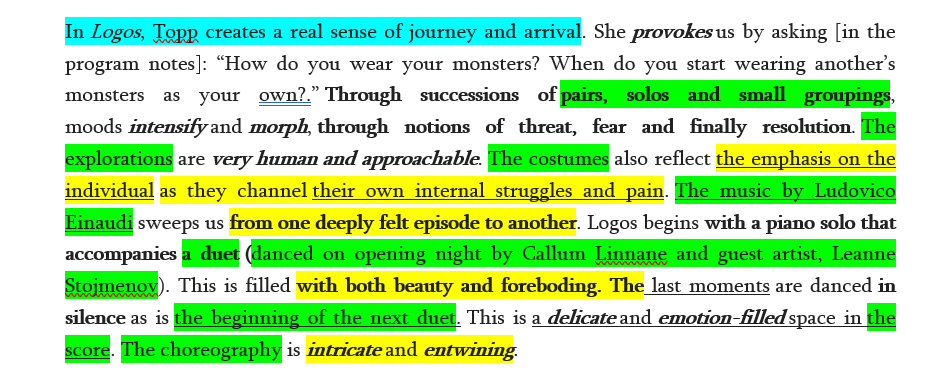Interpreting and reviewing performances is a key element of the Dance curriculum. Students must generate their own interpretations and reviews of performances and consider others' interpretations.
However written interpretations of performances may hold sophisticated language and sentence structures. It is helpful for teachers to deconstruct interpretation responses at both the sentence and whole text level. In the first instance, this should support students reading and comprehension; in the second, it should improve the writing of their own interpretations of artworks.
Unpacking expanded noun (nominal) groups
A noun or nominal group is a group of words that represents or provides information about something (e.g. places, things, ideas) or someone, whether concrete (i.e. physical entity, such as an apple) or abstract (i.e. concept or idea, such as hunger) in a clause.
A noun group can include a single word (such as 'artwork') or be expanded to include pre-and/or post-modifiers which provide clear details about the head noun (such as 'the new artwork which depicts city life'). The pre-modifier 'new' indicates that the artwork has been recently created, while the post-modifier 'which depicts city life' describes the subject matter of the work.
The sentences below relate to Chunky Move's
An Act of Now. The expanded noun group in each has been colour coded. The head noun is pink, the pre-modifiers in blue, and the post-modifiers (also called qualifiers) are in yellow.

Using expanded noun groups adds description and detailed information. (Compare the above sentence with 'Shapes compose …'). Teachers can explicitly teach students the components of expanded noun groups to improve their reading comprehension and writing.
To do this, teachers can encourage students to:
- Highlight (or circle) the head noun in one colour
- Highlight in another colour (or underline) pre-modifiers
- Highlight in yet another colour (or underline with a squiggly line) post-modifiers (Qualifiers).
Curriculum links for the above examples:
VCAVAR038,
VCAVAR045.
Jointly deconstructing interpretation responses
Jointly deconstructing interpretation responses supports students 'to find the themes or key ideas of a text or artwork and respond to it values' (Derewianka & Jones, 2016 p. 266). To jointly deconstruct an interpretation, teachers can use coding to find the various elements used in Dance analyses.
A similar strategy can be used to jointly deconstruct the art reviews, which is the focus of the
Visual Arts: Putting it together section.
The typical structure of an interpretation is:
- Theme Identification and preview of element
- Element evaluation
- Theme reiteration (Derewianka & Jones, 2016 p. 266).
Many of the language features of persuasive writing are relevant to interpretation responses and critical to responding, for example, language choices with attitude, such as those that express feelings, make judgements of behaviours, or evaluate qualities. These attitudes can be amplified or softened through vocabulary choices which increase or decrease the intensity of a viewpoint.
To attend to these kinds of choices:
- The teacher explains that the purpose of an interpretation response in Dance is to find the key theme or idea of the performance and provide comment on its values. They do this by selecting dance elements to justify their interpretation of the intended effects on the audience or viewer (Derewianka & Jones, 2016, p. 266).
- The teacher presents a model text of a paragraph in an interpretation response to the class. This may need to be written by the teacher.
- The teacher reads the text aloud, pausing to clarify any unknown or ambiguous terms.
- The teacher asks students to highlight:
- the key theme or idea (for example, in blue)
- dance elements and choices in another colour (green)
- prepositional phrases which supply details of place (bolded) or adverbials of manner (italics)
- amplified adverbs or adjectives which express attitude (bold italics)
- complex or expanded noun groups (underlined)
- intended consequences (or effects) in yet another colour (yellow).
- The teacher leads a discussion, encouraging students to explain:
- how the topic sentence is supported by elaborations
- how the dance elements are used to realise intended values
- Students can later use the deconstructed paragraph as a model for their own writing.
In the below example, a teacher used a paragraph from
Susan Bendall's review of The Australian Ballet's triple bill program, “Volt”. The review is available on
Dance Australia's website. The text has been highlighted according to the colour-coding above.

Curriculum links for the above examples:
VCAVAR038,
VCAVAR045.